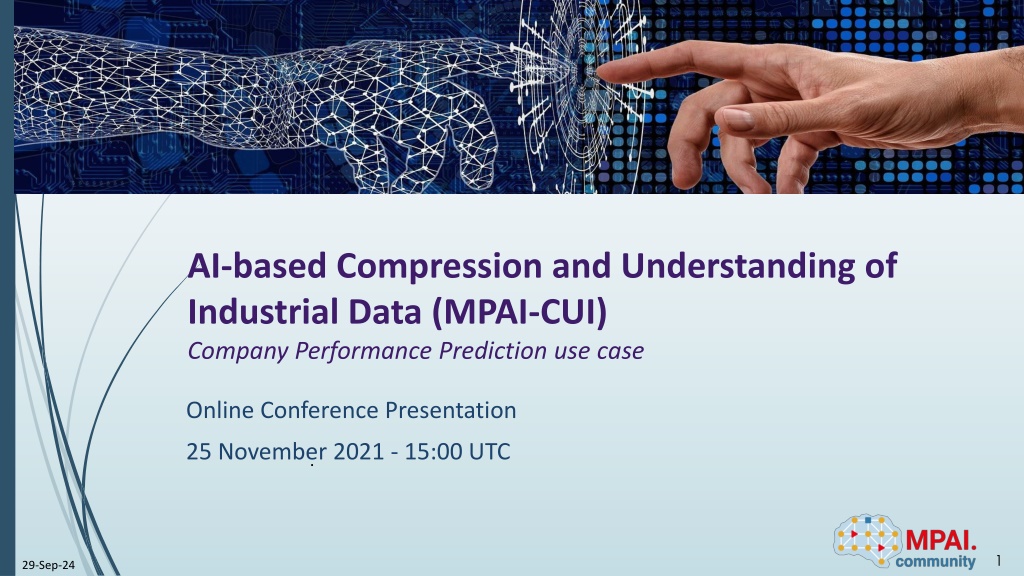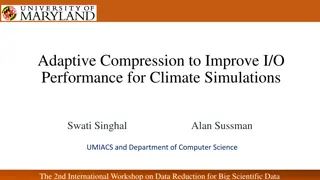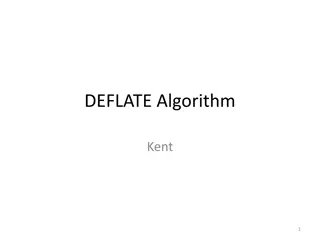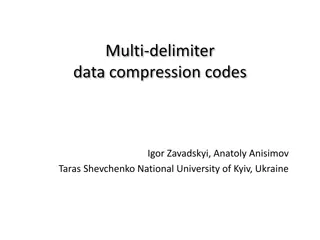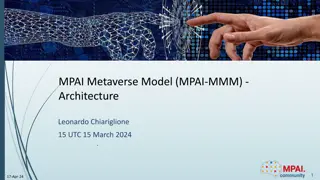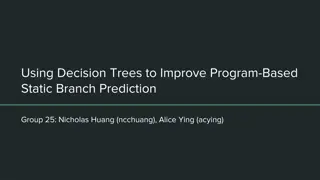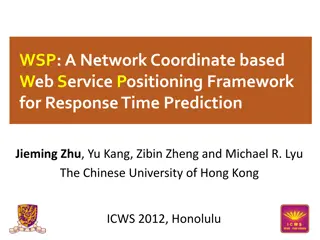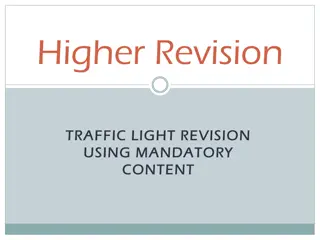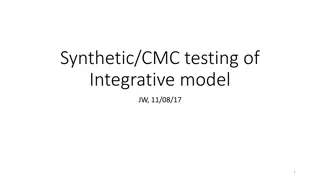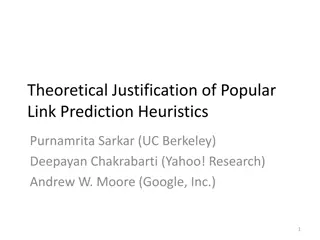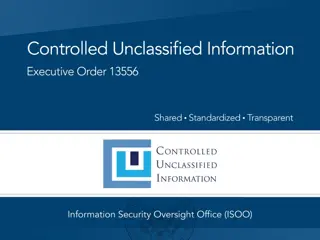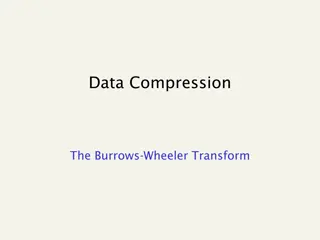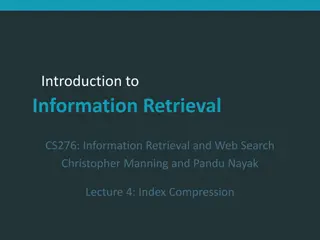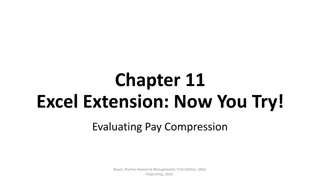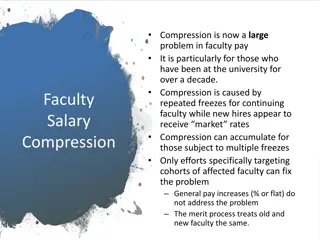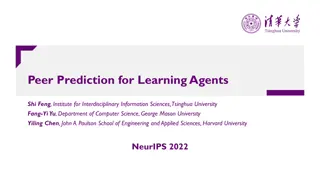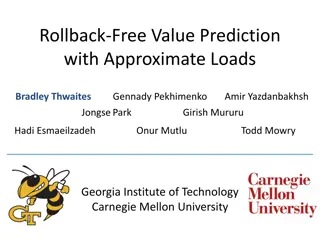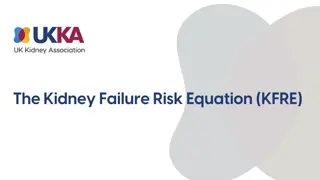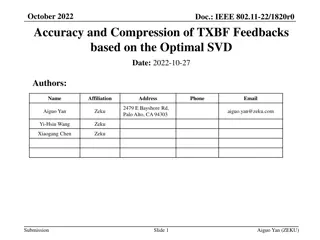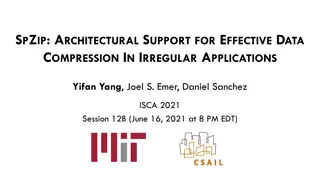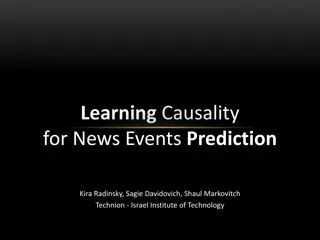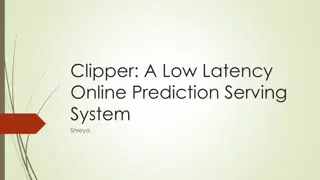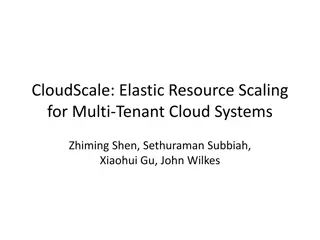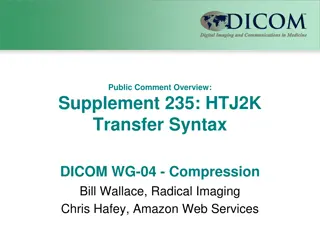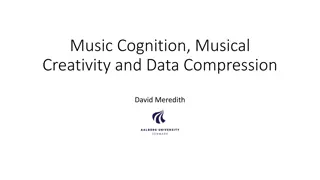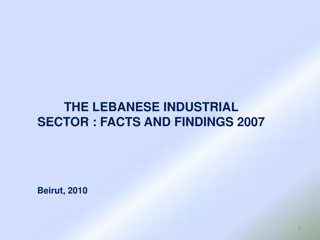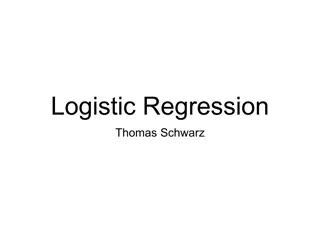AI-Based Compression and Understanding of Industrial Data (MPAI-CUI) - Company Performance Prediction Use Case
AI-based Compression and Understanding of Industrial Data (MPAI-CUI) is a standard developed by the MPEG standards group. This standard focuses on transforming data into a more suitable format for applications. The presentation will cover the introduction to MPAI, applications, a demo for anonymous companies, and a Q&A session. The work is based on four pillars including developing rigorous standards, executing AI modules in a standard framework, setting IPR guidelines, and checking implementations for performance. The rigorous standards development process involves stages from proposal to community comments. MPAI-AIF is an AI framework that includes various modules for workflow, emotion, video analysis, and more. The initiative emphasizes high-quality and timely standards development. MPAI-assigned assessors evaluate implementations based on reliability, robustness, fairness, and replicability for user decision-making.
Uploaded on Sep 29, 2024 | 0 Views
Download Presentation

Please find below an Image/Link to download the presentation.
The content on the website is provided AS IS for your information and personal use only. It may not be sold, licensed, or shared on other websites without obtaining consent from the author. Download presentation by click this link. If you encounter any issues during the download, it is possible that the publisher has removed the file from their server.
E N D
Presentation Transcript
AI-based Compression and Understanding of Industrial Data (MPAI-CUI) Company Performance Prediction use case Online Conference Presentation 25 November 2021 - 15:00 UTC . 1 29-Sep-24
Agenda Introduction to MPAI The MPAI CUI standard Applications of the MPAI-CUI standard Demo of MPAI-CUI for a set of anonymous companies Questions and Answers
Work based on 4 pillars # Pillar 1 Develop standards based on a rigorous process 2 Execute aggregated AI modules (AIM) in a standard AI Framework (AIF) 3 Set IPR Guidelines before a developing a standard International, unaffiliated, not- for-profit organisation 4 Check implementations an MPAI standard for conformance and performance Data coding: transformation of data from a format into another more suitable to an application
Rigorous standards development process Principal Members All Stage 0 Stage 1 Stage 2 Stage 3 Proposal Interest Collection Use Cases Functional Requirements Commercial Requirements Standard MPAI Standard Call for Technologies Community Comments Standard Development Stage 7 Stage 6 Stage 5 Stage 4 Principal Members All All Members
MPAI-AIF: AI Framework AI Workflow (AIW) AI AI AI modules (AIM) Module (AIM) Module AIM Inputs Outputs User Agent Agent User AI AI Internal Storage Module AIM Emotion Module AIM Video analysis Meaning Controller Global Storage Access MPAI Store Communication Access AI Framework (AIF)
High-quality and timely available standards Before initiating a standard, Active Members develop & adopt the Framework Licence (FWL) without values: $, %, dates etc. During the development, any Member making a contribution declares it will make its licences timely available according to the FWL. After the development, Members holding IP in the standard select preferred patent pool administrator.
If we want Good education for humans we should want Good training for AI AI will impact humans more and more. MPAI standards are not enough to guarantee users. MPAI-appointed Assessors assess 4 Performance features of an implementation: Reliability, Robustness, Fairness and Replicability. Users can make informed decisions about which MPAI implementation they should use.
2. The MPAI-CUI standard Prof. Guido Perboli Politecnico di Torino Arisk srl
The AI-based Compression and Understanding of Industrial Data standard Company Performance Prediction use case Powerful and extensible way to predict the performance of a company Financial risks Vertical risks (i.e., seismic and cyber) Predicts the performance of a company, from its governance, financial and risks data in a given time horizon of prediction. First standard released by MPAI
What does performance mean? Default probability: the probability of the company default (e.g., crisis, bankruptcy) in a specified number of future months dependent on financial features Organisational organisational model (e.g., board of directors, shareholders, familiarity, conflicts of interest) Model Index: the adequacy of the Business continuity Index: the probability of an interruption of the operations of the company for a period of time less than 2% of the prediction horizon.
Workflow 1. User defines a Prediction Horizon and feeds Governance, Financial Statement and Risk Assessment data. 2. Governance Assessment produces Governance Features by processing Governance and Financial data. 3. Financial Assessment produces Financial Features by processing Financial Statement data. 4. Risk Matrix Generation produces the Risk Matrix by processing Risk Assessment data. 5. Prediction produces Organisational Model Index and Default Probability by processing Governance Features and Financial Features. 6. Perturbation produces Business Discontinuity Probability by processing Default Probability and Risk Matrix.
AI-based standard Prediction AIM is a neural network that has been trained with a large amount of company data of the same type as those used by the implementation Back testing on a sample of 160.000 companies active and bankrupted Accuracy 85% compared to 37% of the traditional techniques Approved by the scientific community See further details in G. Perboli and E. Arabnezhad. A Machine Learning-based DSS for mid and long-term company crisis prediction. Expert Systems with Applications, 174, 114758, 2021
AI-based standard Novelties of MPAI-CUI Ability to analyse through AI, the sheer amount of data required by regulation, with a controlled loss of information and extract the most relevant one Allows extending the time horizon of prediction up to 60 months, using AI.
Standard development process What next? Future versions or other use cases that will comprise other vertical risks (e.g., Environmental, Social) not included in the present version of the standard and for which AI-based solutions are under development.
3. Applications of the MPAI- CUI standard Prof. Guido Perboli Politecnico di Torino Arisk srl
How MPAI-CUI is going to be used? Company boards: in deploying efficient strategies and identifying possible clues to the crisis or risk of bankruptcy years in advance. It may help the board of directors and decision-makers to make recovery decisions, conduct what-if analysis, and devise efficient strategies. Banks and financial institutions: to assess the financial health of companies that apply for funds/financial help. This aids the financial institution to take the right decision in funding or not that company, having a broad vision of its situation.
How MPAI-CUI is going to be used? Public authorities: to assess public policies in advance and scenarios of public interventions, as well as identify proactive actions to increase resiliency of countries. Society: consumers are guided into selecting state of the art and reliable application using the results of Performance Assessors who competitively rate AIMs from different implementers using Performance Assessment.
A real application: the case study in the Piedmont region of Italy 329 companies in Piedmont that applied for Tranched Cover funding (i.e., Investment in production and infrastructures, Working capital requirements, liquidity stocks, and corporate capitalization; Financial recovery) Initiative employment, as well as access to finance of SMEs to support the competitiveness and See further details in G. Perboli et al. Using machine learning to assess public policies: a real case study for supporting SMEs development in Italy. TEMSCON 2021
A real application: the case study in the Piedmont region of Italy Forward-looking predictive analysis according to investigate the effects of the financial engineering instruments in supporting the financial health of the beneficiary SMEs in Piedmont Ex-ante (2015) and ex-post (2019) evaluation of the socio-economic impact of regional policies, using artificial intelligence Need of the Regional Council of Piedmont for a strategic tool Supporting decision makers in assessing company performance and predict in advance the risk of bankruptcy Favor an efficient allocation of public financial resources
4. Demo of MPAI-CUI for a set of anonymous companies
The 4 Performance attributes Fairness: extent of applicability of Implementation can be assessed by making the training set and/or network open to testing for bias and unanticipated results. Reliability: Implementation that performs as specified by the Application Standard, profile and version the Implementation refers to, e.g., within the application scope, stated limitations, and for the period of time specified by the Implementer. Replicability: Implementation whose Performance, as Assessed by a Performance Assessor, can be replicated, within an agreed level, by another Performance Assessor. Robustness: Implementation that copes with data outside of the stated application scope with an estimated degree of confidence.
